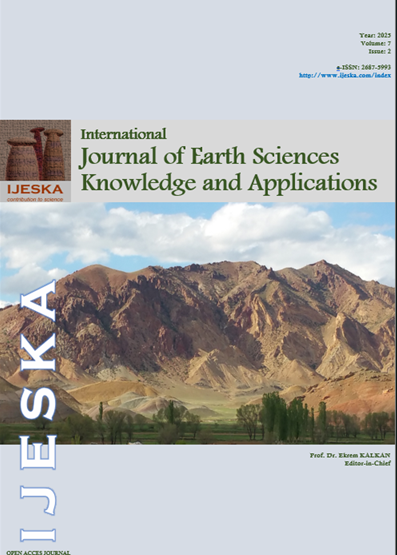Determination of the Composition of Clay and Shale and Their Industrial Potential Associated with the Ameki Formation in Nsugbe and Its Environs, Southeastern Nigeria
Keywords:
Silicate minerals, X-Ray Fluorescence, X-Ray Diffraction, Nsugbe, clayAbstract
Clays possess various industrially significant properties, including plasticity, adsorptivity, ion exchange capacity and shrink-swell potential. This research aims to determine the composition and industrial potential of clay and shale associated with the Ameki Formation in Nsugbe and its environs, Southeastern Nigeria. A total of eight soil samples were collected from four locations and analyzed using X-Ray Fluorescence (XRF) and X-Ray Diffraction (XRD) to assess their mineralogical and chemical properties. These analyses provide critical insights into resource quality and industrial suitability. The XRF data indicate that both shale and clay samples are rich in silicate minerals, as evidenced by high SiO₂ concentrations. The clay samples exhibit a higher Al₂O₃ content, suggesting a greater proportion of clay minerals, whereas the shale samples contain higher levels of Fe₂O₃ and TiO₂, pointing to the presence of Iron-rich minerals and Titanium-bearing phases. The presence of sulfur in both shale and clay, particularly in certain high concentration samples, suggests a possible marine or anoxic depositional environment. Variations in trace element concentrations across the samples likely reflect differences in sediment provenance and depositional conditions. The data also suggest varying degrees of diagenesis, with shale samples indicating a more mature, Iron-rich environment, while clay samples display characteristics of a more weathered or kaolinitic composition. The XRD quantitative analysis identified minerals such as Quartz, Orthoclase, Clinochlore, Albite, Garnet, Vermiculite, Nacrite, Kaolinite, and Rutile, among others. These findings indicate that the Nsugbe clay and shale deposits have significant industrial potential, particularly for use in refractories, bricks, pottery, and ceramics. Long-term monitoring of the Nsugbe deposits can provide insights into sustainable extraction practices. Collaborative efforts with industries could further increase the economic value of these resources while ensuring environmental sustainability, ultimately benefiting the local community.
References
Arua T., Onyeoku O.K., 1978. Clays and Afikpo Pottery in Southern Nigeria. Nigerian Field. Pp. 27-28.
Huber, J.M., 1985. Kaolin Clays. Huber Corporation (Clay Division), Georgia, U.S.A. Joint Committee on Powder Diffraction.
Ikechukwu, C., 2017. Geology and Depositional environment of the Ameki Formation in parts of Bende and Environ Southeastern Nigeria. www.grin.com/ document. Project Report. Pp 1-113.
Jubril, M.D., Amajor, L.C., 1991. Mineralogical Geochemical Aspects of the Afam clay (Miocene), Eastern Nigeria Delta. Nigeria Journal Mining and Geology 27, 95-105.
Keller, W.D., 1964. Processes of origin and alteration of clay minerals: C.I.Rich and G.W. Kunze, Eds.Soil Clay Mineralogy: A Sympossium, Univ, North Carolina Press, Chapel Hill Pp. 3-76.
Manpower Nigeria, 2022. Info@manpower,com.ng.
Malu, S.P., Andrew, C., Malu, F.I., 2013. Chemical characterization of Clay deposit in Taavaan, North Central Nigeria. World Research Journal of Chemistry 1 (2), 31-34.
Murray, H.H., 1960. Clay, Industry minerals and rocks. America Institute of Mining, Metallurgy and Petroleum Engineers, Nigeria, Pp. 159-284.
Nfor, B.N., 2003. Sedimentary facies and the diagnostic characteristics of the Campanian-Eocene deposits of the Anambra basin, S.E. Nigeria. Unpublished PhD thesis submitted to the Department of Geology, Nnamdi Azikiwe University, Awka. Pp. 236.
Nfor, B.N., 2008. Nsugbe Formation (?): A case of non-compliance with stratigraphic nomenclatural procedures. Global Journal of Geological Sciences 6 (2), 139-144.
Ojoh, K.A., 1992. The Southern part of the Benue Trough (Nigeria) Cretaceous stratigraphy, basin analysis, paleooceanography and geodynamic evolution in the equatorial domain of the south Atlantic. NAPE Bulletin 7, 131-152.
Onyekuru, S.O., Iwuoha, P.O., Iwuagwu, C.J., Nwozor, K.K., Opara, K.D., 2018. Mineralogical and Geochemical Properties of Clay deposits in parts of South-Eastern Nigeria. International Journal of Physical Sciences 13 (14), 217-229.
Olusola, J.O., Suraj, A.A., Temitope, M.A., Aminat, O.A., 2011. Sedimentological and geochemical studies of Maastrichtian Clays in Bida Basin, Nigeria: Implication for resource potential, Centre Point Journal 17 (2), 71-88.
Parker, E.R., 1967. Materials data book for engineers and Scientists. Pp. 283. New York: Publ. McGraw Hill Book Co. 8-90.
Reyment, R.A., 1965. Aspects of the Geology of Nigeria. Ibadan University Press. P. 133.
Salihu, S.A., Suleiman, I.Y., 2018. Comparative analysis of physical and chemical characteristics of selected clays deposits found in Kebbi State, Nigeria. International Journal of Physical Sciences 13 (10), 163173.
Singer, F., Sunja, S.S., 1971. Industrial Ceramics. London: Publ. Chapman and Hall P. 56.
Downloads
Published
Issue
Section
License
Copyright (c) 2025 Grace Onmunaonyeshi, Ese Anthony Aladin, Okeke Osita

This work is licensed under a Creative Commons Attribution-NonCommercial-NoDerivatives 4.0 International License.
The authors keep the copyrights of the published materials with them, but the authors are aggee to give an exclusive license to the publisher that transfers all publishing and commercial exploitation rights to the publisher. The puslisher then shares the content published in this journal under CC BY-NC-ND license.



